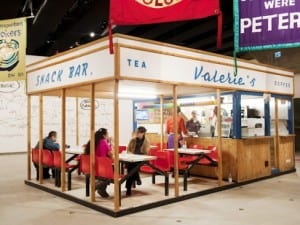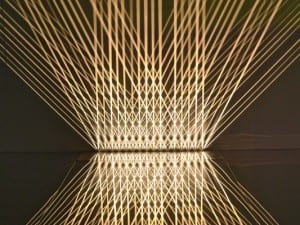Review by Paul Hardman
The fun of visiting Wet Sounds at York Hall Pool in Bethnal Green actually began long before arriving. Explaining to friends that the event was an ‘underwater disco’, or an ‘underwater concert’, was amusing (if deliberately misleading), but then, Wet Sounds does defy easy categorisation.
On its website Wet Sounds is described as “an underwater sound art gallery –a deep listening experience”. In fact this doesn’t quite describe the event at York Hall as it included performance artists, and the organisers had gone to some lengths to light the pool from inside so that the water itself emitted a diffused light to illuminate the hall, providing a distinct visual element to the evening. Wet Sounds then may focus on sound, but it is foremost an experience. Indeed, as one could barely avoid bumping into people floating around the pool, the effect was more friendly than an art gallery or concert situation, this was a group experience, and in this respect perhaps would have more in common with the idea of an underwater disco than an underwater art gallery.
The general difficulty in trying to work out exactly what was going on at any given time added a playful component to the atmosphere. At times it was possible to spot a scuba diver far below when swimming in the deep end, almost like trying to spot dolphins or fish, when swimming at sea. At one point a woman entered the pool dressed from head to foot in a red suit covered in metallic tassels much like tinsel, but it was unclear if she was a performer or an imaginative visitor, such was the general strangeness of the event.
The highlight of the night promised to be a new piece by Pierre Henry commissioned specifically for the evening, Analogy. Henry is a pioneer of Musique Concrète and has been composing electronic music since the 50s, well known pieces include Psyché Rock and Messe Pour Le Temps Présent, and have an eclectic but reasonably accessible sound- organs, bells, voices, and general psychedelia, but essentially music with rhythm, chords and other familiar musical punctuation. An ideal candidate then, to make the most of the Wet Sounds format: a pool, a sound system, speakers both above and below the water, performance artists, and a willing audience of capable swimmers. So the important question, how did it sound?
Well, as anyone who has ever laid in the bath with their head below the water and the radio playing will know, submersion in water does make a difference to sound. High notes become sharper, while middle and bass notes become flattened and sound more distant, generally sounds take on a different texture and seem, well, more watery. Analogy, along with the other pieces played throughout the evening all could loosely be described as ambient – that is to say, they were not structured pieces of music as one would usually understand it, completely loose in form and featuring long distorted drones and highly engineered samples of noises rather than recognisable instruments. These were pieces that perhaps seem a suitable choice for listening while floating along with another fifty or so people in pool in East London at the tail end of the weekend. But here, in a way, is where the problem of Wet Sounds begins. Although the music or sound art on offer was pleasant, and did provide a degree of sonic interest, it did feel as thought the situation was not being tested as much as it could have. Ambient and atmospheric sounds do suit listening to in water, but surely there are more possibilities.
Floating on ones back with ears below the surface, and taking in the beams and glass roof of the Hall’s ceiling, equally floaty music made a fine accompaniment, but at some point the need for experimentation begins to creep in. The York Hall pool depth of 5 metres meant that diving down to hear any sonic differences was restricted mostly by ones own ability to withstand the water pressure and hold ones breath, so this activity of diving and then emerging provided a further way to experience the soundscapes. Ultimately though, it would have been better to be able to sample a wider gamut of sounds and noises, and yes, even conventional music. How for instance would a piano sound when heard deep in the pool, or a human voice singing, or a cello, or a pop song? Hearing the sound art in this context was a great way to appreciate the immersive aspect of it, but essentially, it felt as if there was a lack of variety in the sounds on offer. Wet Sounds wetted the appetite for an immersive audio experience, but provided a range of sounds too narrow to be fully satisfying.
However, if the aim of the Wet Sounds organisers was to provide a different way to think about how music and sound art is experienced, then they have achieved it. The ambition of such an unusual event sets an example for how others could attempt to expand the possibilities for the aesthetic experience. The message is not to readily accept perceived limitations – even an old council owned swimming pool can become something extraordinary – let’s hope their ambition keeps growing. If the accompanying sounds could be as playful as the situation then Wet Sounds could become something really rather special.
Spanning two months from 28 Jan 2011 – 26 March 2011, Wet Sounds installs at swimming pools at 7 UK cities. The final event A History of Sound Art presented at Fierce 23-27 March. For more information and tickets please visit www.wetsounds.co.uk





